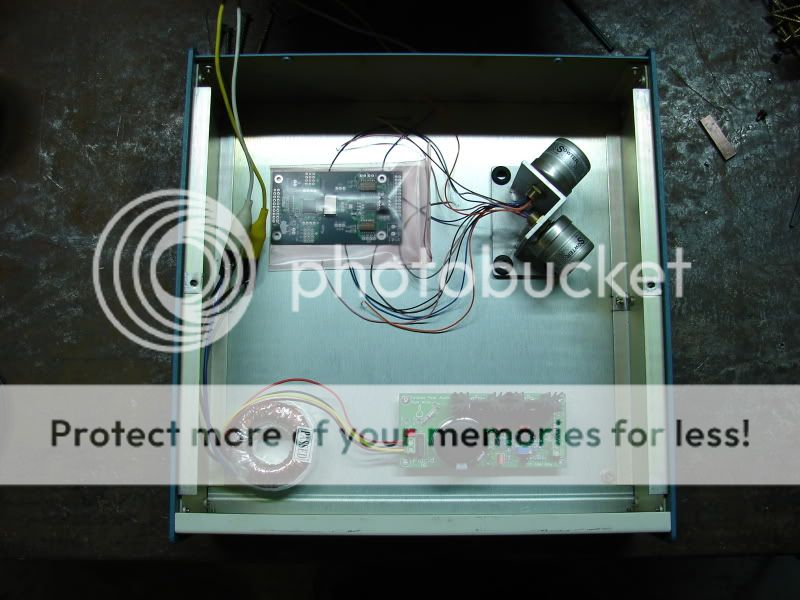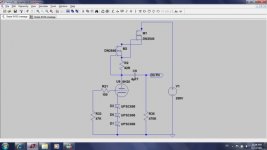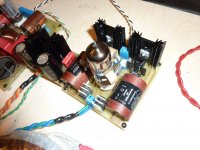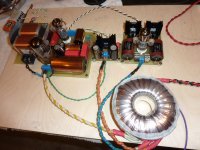Just wanted to say thank you to everyone in this thread, it's been a great resource to me.I'm currently building my Buffalo III and decided to go with Sowter 3603 transformers with the OCC wire option. There will be a build thread for it soon, but this is where I'm at so far:

Will be nice with a building thread... Even nicer with the finally (sound) impresions...
I personally do not like long wires. It is not better to place the DAC board just over the transformers (to have the shortest coupling wires)?
I personally do not like long wires. It is not better to place the DAC board just over the transformers (to have the shortest coupling wires)?
I agree.
Going back a few posts from Joe Rasmussen and using resistors on the primary, when using a tube final stage. Joe mentions any tube with decent gain should work but I'd like to see a little more specifics here.
Here's three examples from the thread:
First is the transformer with no primary resistors having about 2v at the secondary.
Second is using 330R's from the primary leads connected to ground with a secondary output of 1.35V.
Third is using 3R on the primary as above, but having an output of 30mv.
I would naturally assume the tubes that have the most gain be used with the least voltage out.
I am considering diferent tubes and each has different operating points and different amplicifation factors. My thoughts were a 6H30P (mu 15), 6922 or 6n6P (mu from 22 to 30) and another Russian tube the 6N2P-EV (mu 100).
I think Joe infers that using a transformer with the low resistance on the primary where the transformer Vout is 30mv (should) have the best sonics as it is closer to a current out and use a tube final stage.
I guess my question is how much gain or what amplification factor would work best without producing too much voltage for the pre-amp or amp?.. just a note on the pre I'm using.. it's a low mu with an amplification factor of either 2 or 4 depending on which tube I use. Also to mention.. I'm using the Feastrex transformers that I just received (THANKS KENJI!!!!)
Any thoughts or insights would be helpful at this stage of development.
Thanks!
JD
Here's three examples from the thread:
First is the transformer with no primary resistors having about 2v at the secondary.
Second is using 330R's from the primary leads connected to ground with a secondary output of 1.35V.
Third is using 3R on the primary as above, but having an output of 30mv.
I would naturally assume the tubes that have the most gain be used with the least voltage out.
I am considering diferent tubes and each has different operating points and different amplicifation factors. My thoughts were a 6H30P (mu 15), 6922 or 6n6P (mu from 22 to 30) and another Russian tube the 6N2P-EV (mu 100).
I think Joe infers that using a transformer with the low resistance on the primary where the transformer Vout is 30mv (should) have the best sonics as it is closer to a current out and use a tube final stage.
I guess my question is how much gain or what amplification factor would work best without producing too much voltage for the pre-amp or amp?.. just a note on the pre I'm using.. it's a low mu with an amplification factor of either 2 or 4 depending on which tube I use. Also to mention.. I'm using the Feastrex transformers that I just received (THANKS KENJI!!!!)
Any thoughts or insights would be helpful at this stage of development.
Thanks!
JD
Last edited:
I guess my question is how much gain or what amplification factor would work best without producing too much voltage for the pre-amp or amp?.. just a note on the pre I'm using.. it's a low mu with an amplification factor of either 2 or 4 depending on which tube I use...
JD
There are infinite number of variables in your question/query. I don't think too much gain is going to be a problem and with some enough gain is going to be a perceived problem to them because the fall short of 2V?
To that I would add that a reasonable low output impedance would be part of the requirement as well, at least to me.
Also, that 3R value could be tweaked upwards (and downwards) even if that is further away than ideal. But I would say than an exact target of 2V is not that important to me and as low as 1V would not disturb me.
Here is a circuit worth looking out - the Line Stage on the right side:

The 25K could be increased to 47K no problem.
I have suggested this to another Sabre DAC user that I supplied a pair of transformers. He said he is going to try it.
Cheers, Joe R.
Last edited:
Joe, I'm just going to use a simple single stage as I do not want or need another entire pre-amp. A single triode with a CCS load. 1/2 of the tube for each channel. AS I mentioned I have a choice of tubes that I can tweek the operating points to get to good places in the load lines and my ears. Allens pre-amp is waaayyyy over the top and over complicates what I want to do..
The attached pic is the basic setup (with different values for the load to the transformer and to the tube I'll end up using)
So I can play with the transformers primary to suit the tube, or I can play with the tube to suit the primaries of the transformer.
I was also considering your earlier statement that there may be better sound quality as the primary resisance got to the 3 ohm range...(1.5 R in my case because of using Buff2's in daul mono, one per channel).
My question was pertaining how much actual tube amplification is needed to the different primary setups, not looking for a precise 2v output.
If the dac & transformer is putting out volts instead of mv's then a tube with an amplification factor of 100, I think, would not be suitable. If I use a tube whos amplification factor is 15 on a tube with mv output, that too I believe would not be workable as the output would be too low for my pre-amp which has about as much amplification as a passive (just basically a volume control).
JD
The attached pic is the basic setup (with different values for the load to the transformer and to the tube I'll end up using)
So I can play with the transformers primary to suit the tube, or I can play with the tube to suit the primaries of the transformer.
I was also considering your earlier statement that there may be better sound quality as the primary resisance got to the 3 ohm range...(1.5 R in my case because of using Buff2's in daul mono, one per channel).
My question was pertaining how much actual tube amplification is needed to the different primary setups, not looking for a precise 2v output.
If the dac & transformer is putting out volts instead of mv's then a tube with an amplification factor of 100, I think, would not be suitable. If I use a tube whos amplification factor is 15 on a tube with mv output, that too I believe would not be workable as the output would be too low for my pre-amp which has about as much amplification as a passive (just basically a volume control).
JD
There are infinite number of variables in your question/query. I don't think too much gain is going to be a problem and with some enough gain is going to be a perceived problem to them because the fall short of 2V?
To that I would add that a reasonable low output impedance would be part of the requirement as well, at least to me.
Also, that 3R value could be tweaked upwards (and downwards) even if that is further away than ideal. But I would say than an exact target of 2V is not that important to me and as low as 1V would not disturb me.
Here is a circuit worth looking out - the Line Stage on the right side:

The 25K could be increased to 47K no problem.
I have suggested this to another Sabre DAC user that I supplied a pair of transformers. He said he is going to try it.
Cheers, Joe R.
Attachments
Last edited:
@ Jeffrey
I had the same idea about a simplistic schema with CCS, with some pentodes, these would give min. x50 gain , with output impedance under 3k :
GroupBuild Forum - 300B SE Project, Part 9 - E180F, E280F, D3a pentodes - triode connected - Damir, March 09, 2006 at 14:19:29
Mullard E180f , 6688 , on ebay few bucks!
Russian 6J9P-e, 6J49P-dr , also may be used
R.C.
I had the same idea about a simplistic schema with CCS, with some pentodes, these would give min. x50 gain , with output impedance under 3k :
GroupBuild Forum - 300B SE Project, Part 9 - E180F, E280F, D3a pentodes - triode connected - Damir, March 09, 2006 at 14:19:29
Mullard E180f , 6688 , on ebay few bucks!
Russian 6J9P-e, 6J49P-dr , also may be used
R.C.
I still think somebody should try this with a Sabre DAC using Tubes.

Normally Tubes are only good for voltage DACs, but use a transformer like this and you will have a Tube I/V stage - and it is the Sabre DAC that makes it possible - offset current = 8mA (I wouldn't do this with any other DAC I could think of). It can be pulled all the way to ground on the Primary and the Secondary grounded - and just input to the grid of your favourite Tube - and away you go.
Somebody should try it - requires gain about 50.
Cheers, Joe R.
Hi Joe,
Can you explain why you wouldn't do this with any other DAC chip? Say, for instance, TP's other current DAC offering, PCM1794A? I understand that with I/V resistors=3 for 2Vrms you'd need gain=120, but any other reasons? As far as I can tell the DC offset would not be an issue with the transformer primary as long as the resistors are well-matched, but I could be totally wrong...
Thanks for your thoughts.
John
Hi Joe,
Can you explain why you wouldn't do this with any other DAC chip? Say, for instance, TP's other current DAC offering, PCM1794A? I understand that with I/V resistors=3 for 2Vrms you'd need gain=120, but any other reasons? As far as I can tell the DC offset would not be an issue with the transformer primary as long as the resistors are well-matched, but I could be totally wrong...
Thanks for your thoughts.
John
Just put a 6 ohm resistor across the Sabres OP.
I don't think you need the ground reference.
T
->
My Buffalo 3 DAC should be arriving any day now, and I'd be grateful for some quick advice.
I recently picked up an ACF tube buffer (zero gain and Very low impedance) to incorporate as the output stage of the DAC but now realize I cannot do it because it is single ended and the chip has balanced outs only.
If I incorporate a resistor/transformer as the current/voltage stage as others are doing here in this thread- could I use the secondaries of the transformer as the input of the ACF tube buffer for a final stage?
My Buffalo 3 DAC should be arriving any day now, and I'd be grateful for some quick advice.
I recently picked up an ACF tube buffer (zero gain and Very low impedance) to incorporate as the output stage of the DAC but now realize I cannot do it because it is single ended and the chip has balanced outs only.
If I incorporate a resistor/transformer as the current/voltage stage as others are doing here in this thread- could I use the secondaries of the transformer as the input of the ACF tube buffer for a final stage?
Hi Joe,
Can you explain why you wouldn't do this with any other DAC chip? Say, for instance, TP's other current DAC offering, PCM1794A? I understand that with I/V resistors=3 for 2Vrms you'd need gain=120, but any other reasons? As far as I can tell the DC offset would not be an issue with the transformer primary as long as the resistors are well-matched, but I could be totally wrong...
Thanks for your thoughts.
John
The context was a DAC with voltage offset, usually near 2.5V but also in some cases 1.65V - you can't just bring it to ground without potential damage (know somebody who did and poof!!).
DACs like PCM1792/1794/1796 (also DSD prefix) all have zero offset voltage (they do have offset current, but that hardly matters) and hence no danger to bring it to ground or even short it.
The Sabre DAC does have an offset voltage, 1.65V, but in this instance it can be taken to ground because its output impedance acts as a current limiter and that is unlike other DACS.
But Terry is right, you could use a single 6R across the the output phases without reference to ground. No DC will flow. The secondary is grounded.
But I have a sneaky suspicion that it will sound better with a 3R+3R split and grounded. But whoever builds should try both, and then we would be happy if he reported his findings here.
Cheers, Joe R.
Just put a 6 ohm resistor across the Sabres OP.
I don't think you need the ground reference.
T
Hi Terry
Yes, see above, the point I've made as well. But both should be tried if the opportunity presents itself.
Cheers, Joe R.
The context was a DAC with voltage offset, usually near 2.5V but also in some cases 1.65V - you can't just bring it to ground without potential damage (know somebody who did and poof!!).
DACs like PCM1792/1794/1796 (also DSD prefix) all have zero offset voltage (they do have offset current, but that hardly matters) and hence no danger to bring it to ground or even short it.
Thanks Joe. I've been mulling this over, and now get the difference between DC current offset & DC voltage offset DACs in this context. Can hardly believe I'm this dense/ took so long to get it...
I have a COD module in transit. Once I get a chance to mess with it, I'll start a new thread.
Thanks again for your help.
Regards,
John
...now get the difference between DC current offset & DC voltage offset DACs in this context.
I now avoid current DACs with offset voltage - so that I can do direct-coupled (no caps in signal path) zero feedback I/V post DAC circuit. The other point is that, in this case, offset current is not a problem, but oh boy, offset voltage makes offset current a real problem. But once you get it, as you say, it helps a lot.
My thanks to Terry who I used as a sounding board on this, some time back.
Cheers, Joe R.
I still think somebody should try this with a Sabre DAC using Tubes.

Normally Tubes are only good for voltage DACs, but use a transformer like this and you will have a Tube I/V stage - and it is the Sabre DAC that makes it possible - offset current = 8mA (I wouldn't do this with any other DAC I could think of). It can be pulled all the way to ground on the Primary and the Secondary grounded - and just input to the grid of your favourite Tube - and away you go.
Somebody should try it - requires gain about 50.
Cheers, Joe R.
Hello Joe,
I have tried this with a Buffalo24 board, using Sowter 8347(1:17) followed by SRPP stage using 6111 subminiature tubes.
First I tried 3R registers. The result was amazingl!! Lots of air and more details without losing too much dynamics comparing to a Buffalo32 with opamp I/V stage.
One problem was too much gain and I could not use more than a quarter of volume control. So, I replaced 3R registers with 1R, and the sound seems to be as good as with 3R (supposed to be better?) and I now can use the volume control in comfortable range.
One concern though. Isn't 1R register too low for the DAC? I asume it is safe since I don't see smoke, but I would like to have your confirmation.
Thank youl.
How much gain does the stage have?
Thanks
JD
Thanks
JD
Hello Joe,
I have tried this with a Buffalo24 board, using Sowter 8347(1:17) followed by SRPP stage using 6111 subminiature tubes.
First I tried 3R registers. The result was amazingl!! Lots of air and more details without losing too much dynamics comparing to a Buffalo32 with opamp I/V stage.
One problem was too much gain and I could not use more than a quarter of volume control. So, I replaced 3R registers with 1R, and the sound seems to be as good as with 3R (supposed to be better?) and I now can use the volume control in comfortable range.
One concern though. Isn't 1R register too low for the DAC? I asume it is safe since I don't see smoke, but I would like to have your confirmation.
Thank youl.
Hello Joe,
I have tried this with a Buffalo24 board, using Sowter 8347(1:17) followed by SRPP stage using 6111 subminiature tubes.
One problem was too much gain and I could not use more than a quarter of volume control.
Isn't 1R register too low for the DAC? I asume it is safe since I don't see smoke, but I would like to have your confirmation.
Thank youl.
Not surprising. The figure shows a 1:1 transformer, and since you're using a 1:17, I think you must be getting more than 20db gain before going into your SRPP stage. The 6111 is medium mu, so depending on how you have it set up- you may have a lot of unnecessary gain (overall).
Last edited:
Just ran my numbers..... as I mentioned in an earlier post I'm using a dual mono setup.
With a 1:1 traffo, using 10R on each primary leg to ground (assuming 97.5 R on the B2 DAC in mono) for each channel, that should net around .2v at the output of each transfomer. With a single gain stage of a 6N6P with a gain of about 20db, output voltage should be close to 2v. per channel. Right at my desired target.
JD
With a 1:1 traffo, using 10R on each primary leg to ground (assuming 97.5 R on the B2 DAC in mono) for each channel, that should net around .2v at the output of each transfomer. With a single gain stage of a 6N6P with a gain of about 20db, output voltage should be close to 2v. per channel. Right at my desired target.
JD
1R is no problems as the ESS9018 chip can be used down to 0 Ohms into virtual ground. That is what the IVY uses.
Hello Joe,
One concern though. Isn't 1R register too low for the DAC? I asume it is safe since I don't see smoke, but I would like to have your confirmation.
Thank youl.
Hi hkminn,
Interesting approach!
The Sowter datasheet suggests that the IV resistor may also be used across the secondary winding of the transformer (taking into account that the value of the resistor is reflected on the primaries by the ratio of the transformer (18.7) squared: 18.7 x 18.7= 350). Did you try that also?
What are the drawbacks of the high transform ratio? Or is there something like a free lunch?
Datasheet for Sowter 8347 and 9055:
Sowter Type 8347 DAC INTERFACE TRANSFORMER
Peter
Interesting approach!
The Sowter datasheet suggests that the IV resistor may also be used across the secondary winding of the transformer (taking into account that the value of the resistor is reflected on the primaries by the ratio of the transformer (18.7) squared: 18.7 x 18.7= 350). Did you try that also?
What are the drawbacks of the high transform ratio? Or is there something like a free lunch?
Datasheet for Sowter 8347 and 9055:
Sowter Type 8347 DAC INTERFACE TRANSFORMER
Peter
- Status
- This old topic is closed. If you want to reopen this topic, contact a moderator using the "Report Post" button.
- Home
- More Vendors...
- Twisted Pear
- Buffalo II & transformers


